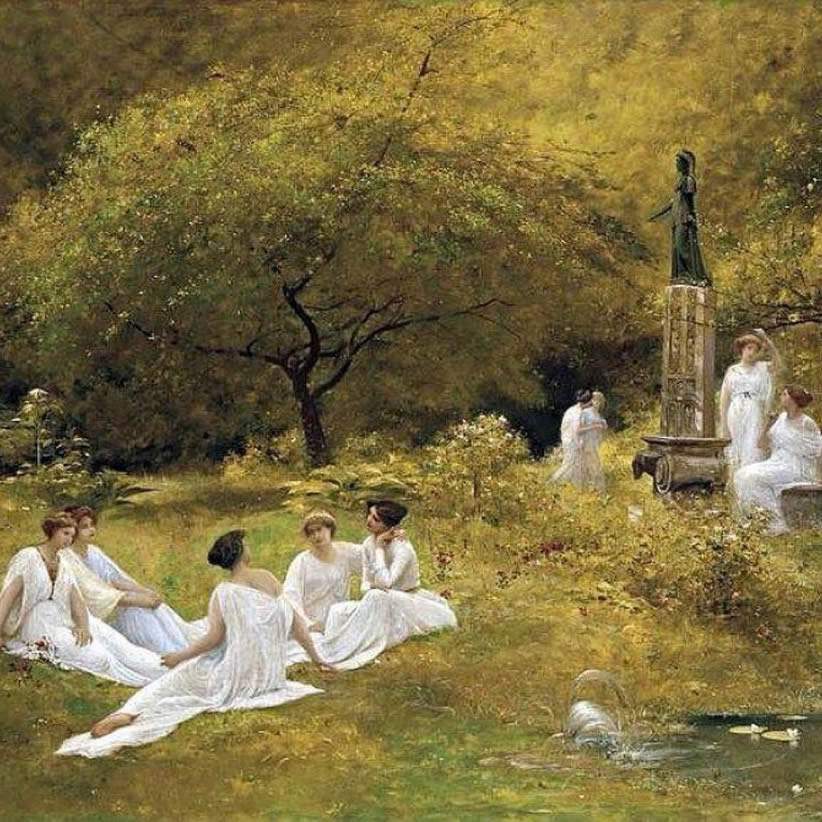EDITOR’S NOTE: This essay is published here with the gracious permission of The Imaginative Conservative who published it in November 2012 with permission from The St. John’s Review (Volume 35, No. 2, 1984).
The part of the title of this talk which I asked to have announced is “The Roots of Modernity.” But there is a second part which I wanted to tell you myself. The full title is: “The Roots of Modernity in Perversions of Christianity.”
The reason I wanted to tell you myself is that it is a risky title, which might be easily misunderstood, especially since “perversion” is strong language. So let me begin by explaining to you what I intend and why I chose to talk to you about such a subject.
I think you will recognize my first observation right off; you might even think it hardly worth saying. It is that we live in “the modern age.” We never stop trying to live up to that universally acknowledged fact: We are continually modernizing our kitchens, our businesses, and our religions.
Now, what is actually meant by “modern times?” The term cannot just mean “contemporary” because all times are contemporary with themselves. Modern is a Latin word which means “just now.” Modern times are the times which are in a special way “just now!” Modernity is just-nowness, up-to-date-ness. Perhaps that doesn’t seem like a very powerful distinguishing characteristic, because, again, what times are not just now for themselves? How is our modern age distinguished from ancient times, or from that in-between era we call the “middle” ages, all in comparison with our present times?
Well, the first answer is very simple. We live differently in our time from the way those who came before us lived in theirs. For instance, when we speak of something or even someone as being “up to date,” we are implying that what time it is, is significant, that time marches, or races, on by itself, and we have the task of keeping up with it. Our time is not a comfortable natural niche within the cycle of centuries, but a fast sliding rug being pulled out from under us.
Furthermore, we have a sense of the extraordinariness of our times; we think they are critical and crucial, that something enormous is about to be decided, or revealed. You might say that we don’t just have a sense of doom or delivery, but that things are, in fact, that way. And yet such a feeling of crisis has marked decades of every century for the last half-millennium. Modernity itself is, apparently, a way of charging the Now with special significance.
To ask about the roots of modernity is to ask what made this state, this chronically hectic state, we are in come about. By the roots of modernity, I mean the true beginnings, the origin of our way of being in time.
At this point, you might think that I am talking of history and that I am planning to lecture to you on the various historical movements which led up to our day. But not so. Such “movements” – be they the Protestant Reformation or the Industrial Revolution – are themselves only the names given to the sum of events which are in need of explanation. Let me give an example. Suppose I were to explain the resolve or habit some of you live with of turning directly to Scripture for your knowledge concerning faith, by saying that you are “products” of the Protestant Reformation. This historical explanation would sound as if I were saying something significant, but, in fact, it would say nothing about the inner reasons why a part of Christianity decided to return directly to the Bible. And inner reasons, namely ideas, are in the end the only satisfying explanation of the actions of human beings.
Next, in explaining my title, I have to tell you what I mean here by Christianity. I do not refer to the faith itself. Nor do I mean specific dogma, that is to say, dogmatics. What I do mean are certain spiritual and intellectual modes, certain ways of approaching thought and life and the world, which are perhaps more noticeable even to a non-Christian than to someone who lives within Christianity. I hope the examples I mean to give you will clarify what I am saying.
And finally, I want to define as carefully as possible what I mean by a “perversion.”
I do not mean something blatantly heretical or terrifically evil, which we moderns should cast out. For one thing, I am not myself a Christian, and it is not my business to demand the purification of other people’s faith. For another, I mean to show that all of us, simply by reason of living as moderns, have been deeply penetrated by these perversions and that we could hardly carry on without them. They are an unavoidable part of our lives. When I say “unavoidable” I do not mean that there is no possibility and no point in resisting them. In my opinion, there are no inevitable movements but only human beings willing, and on occasion unwilling, to go along. These perversions are unavoidable only in the sense that once certain very potent trains of ideas had been set into the world, they were bound to be carried beyond themselves, to be driven to their inherent but unintended conclusion.
Perhaps, then, I should speak less dramatically and say that it is the secularization of certain Christian notions that is at the root of modernity. Nevertheless, I do want to hold on to the stronger word to describe this development, and for the following reasons.
You all know what the sin of Satan is said to have been. It was resistance to God and rebellion against his creator, and its cause was pride, the sin of sins. Satanic pride, any pride, is, theologically speaking, a perverse will, literally a will that turns things awry. In particular, it overturns the relation of the creature to his creator. Satan rebels because he cannot bear to be derivative and subordinate, and least of all to be more remote from the center of knowledge than Christ. He communicates that terrible impatience to Eve in the Garden when he tempts her with the fruit of knowledge and promises “Ye shall be as gods, knowing good and evil,” – in Latin, this is the scientia boni et mali.
Now, as it happens, the men of the generation around 1600 Anno Domini – the generation which was most pointedly responsible for modernity and in whose writings its roots are to be most explicitly seen – these men were also unspeakably proud. I am thinking of names probably familiar to you: of Galileo Galilei, of Rene Descartes and of Francis Bacon, an Italian, a Frenchman and an Englishman. You need only glance at the engraving published as the frontispiece of the most accessible translation of Descartes’ works to see how haughty he looks.
Nonetheless, anyone who reads their books must be struck with the sober and restrained character of their writing. They keep claiming that they are not revealing great mysteries or setting out momentous discoveries. They present themselves as merely having found a careful, universally accessible method, which, once they have set it out, can be used by all mankind. All that is needed is the willingness to throw off old prejudices and preoccupations, all that Bacon calls our “idols;” we are to throw off the nonsense of the ages and to apply sober human reason to clearly-defined problems. In other words, these initiators of modernity are preaching rebellion against the traditional wisdom, but in measured, careful, sometimes even dull words, so dry that students often get rather bored with reading them. That is, they get bored partly with the measured dryness with which this tremendous rebellion is announced, partly because the Baconian-Cartesian revolution is so much in our bones, has been so precisely the overwhelming success its authors expected it to be that we, its heirs, hardly recognize the revolutionary character of its original declarations of independence.
But the overweening pride of these first moderns was not essentially in the fact that they were aware of opening a new age. That was too obvious to them and they were of too superior a character to glory much in it. Their pride was the pride of rebellion, though not, perhaps, against God. Interpretations differ about their relations to faith, and I think they worshipped God in their way, or at least had a high opinion of him as the creator of a rationally accessible world, and they co-opted him as the guarantor of human rationality. Their rebellion is rather against all intermediaries between themselves and God and his nature. They want to be next to him and like him. So they fall to being not creatures but creators.
Let me give you a few bits of evidence for this contention. First, they all had a cautiously sympathetic respect for Satan.
For example, as you may know, both Galileo and Descartes had trouble with the publication of their works. Galileo had such trouble because he supported Copernicus in his view that the earth is not fixed at the center of the universe, but travels around, a wanderer (which is what the word planet literally means) in the world, so that we human beings become cosmic travelers, able to see the heavens from various perspectives. Now, the authorities of the Catholic Church at that time, considered the fixed central place of the earth as crucial to the character of the place God had chosen to become incarnate. But they were not so crude as to quarrel with an alternative astronomical hypothesis if it happened to be mathematically satisfying. What they forbade Galileo to assert in public was that this was the true reality and not just a possible theory. In this, they were in the best tradition of ancient science. The astronomers had always known that there were alternative mathematical hypotheses for explaining the heavenly motions, depending on one’s point of view. The Ptolemaic, geocentric system was simply the one more in accord with the evidence of our unaided sense – everyone can see the sun running through the sky – and the system then and now most useful for navigation. What the Church required of Galileo was that he should keep science hypothetical instead of claiming that it revealed the reality of the heavens; this earth’s motion could be asserted hypothetically but not as a fact. We all know that he pretended to yield, but is said to have muttered: “And yet it moves.” By that stubbornness, he showed himself the archetypal scientist. I mean, he made it possible for that word scientia which means simply knowledge, as in the scientia boni et mali, to come to be confined to such knowledge of reality as Galileo had, which is what we call science today. Among such realities is the fact that the heavens are full of real matter which is indistinguishable from and moves just as do the stones on earth.
Now Galileo and also Descartes, who had similar troubles with the theological faculty of the University of Paris, the Sorbonne, did find a publisher in Holland. And this Dutch publisher had a most revealing emblem which includes a very serpent-like vine twining around a tree, an apple tree, I imagine, whose fruit is the new scientia, modern science. Of course, the serpent is Satan’s shape as he tempts human beings to knowledge beyond that proper to a creature: “Ye shall be as gods, knowing good and evil.”
A few more examples. When Bacon first sets out those procedures which are now smoothly familiar under the name of the scientific method, he constructed a type of experiment he slyly calls light-bringing or “luciferic” experiments. You all know that the angelic name of Satan before his revolution in heaven and his fall was Lucifer, or the Light-bearer. Again, some of you have probably read Milton’s Paradise Lost, and perhaps you can compare Milton’s Satan with Dante’s. Dante’s Satan is a horrible, inhuman figure encased in ice in the lowest hell in Inferno. Milton’s modern Satan has much grandeur. He is in fact represented as an overwhelmingly proud, antique, even Homeric, hero. Or one last example: Dr. Faustus, an evidently not altogether fictional scholar who stands on the brink of modernity, has a real intimacy with the devil. And in those old tales from which the famous later treatments are taken Faust sells his soul to him not only for the pleasures and the dominion of the world, but also for the secrets of modern astronomy and algebra.
Here, let me repeat my caution: I am not saying that these founders of modernity played silly and wicked blasphemous games, but only that they still had the theological learning and the grandeur of imagination to know what their enterprise resembled.
Now let me give you three enlightening complementary facts. Bacon wrote a book, a kind of scientific utopia called the New Atlantis, a place which is an imaginary island lying off the shore of America. The book is, in fact, the first description of a scientific research complex. Bacon calls the group of people in charge of it “the College of the Six Days’ Work.” Furthermore, Galileo’s work called the Two New Sciences, in which he sets out the beginning of modern physics, is a dialogue taking place on a succession of days, possibly six. And finally, Descartes’s Meditations, intended to prepare the world for modern science, takes place in six sessions. There is no question in my mind but that these men were thinking of themselves as re-doing God’s work of the creation, as creating a new world or re-creating the old one in an accessibly intelligible, illuminated form, and as revealing what they had done in a new kind of scripture. They were light-bringers, making us, their heirs, like gods, knowing a source for re-making the world, for better or worse, as new creators. Here, finally, is the point I have been leading up to; you may find it a little outrageous, but see whether you can deny it: We, almost all of us, have so totally absorbed such an attitude that we hardly notice what we are saying anymore. Let me ask you when you have last said that you wanted to “do something creative” with your life, or have been told to “think creatively” or called someone you admired “so creative.” In fact, we are in the habit of referring to all our more exciting activities as “creative.” But creativity is a precise theological idea whose meaning we are partly forgetting, partly perverting to our modern use. Creativity means the ability to bring something into being out of nothing, in Latin, “ex nihilo,” from the very beginning, as God is implied in Genesis to have separated the heavens and the earth out of a chaos of his own creating.
Clearly, we are quite incapable of such production. For example, take a potter to whose work we may refer as “very creative.” But a potter has clay out of which the pottery is fashioned and a wheel on which it is thrown. The ancient Greeks referred to all such work as “making,” for which the Greek word is poesis, and they used that word particularly for that kind of making which is done in words and which we still call poetry. Creative poetry is, therefore, strictly speaking, a contradiction in terms, and yet that adjective has a revealing significance. For a maker works on given material according to a tradition and from a pattern. But a creator is free of all those restrictive circumstances and bound above all by the inner demands of self-expression. It makes for that kind of production we peculiarly think of as “Art,” with all its courage, cleverness, sophistication, and emphasis on the artist’s individuality. The story of modern art is the story of the triumph of rebellious creativity, of creativity divorced from its proper, superhuman agent.
But artistic creativity is only a later outcome of the original perversion of the notion, and, indeed, a reaction to it. The first, and still predominant application of the notion of human creativity is the re-enactment of the six-days’ work I have already referred to. That is to say, it is the science of nature and its application, called technology, which appears to put humanity in control of the creation.
Now modern science, it seems to me, has two separate roots. One is Greek. The Greeks began the development of those mathematical tools which characterize modern science. They also distinguished and named the science of physics. Physics is a Greek word derived from physis, which means growth and movement and is usually translated as “nature.” But the natural science of the Greeks was, I think, in its very essence, incapable of mechanical application. It was pure theory – theory is another Greek word which means “beholding,” “contemplation.” The Greek physicists looked on natural beings but they did not control nature. You will not be surprised when I say that I think this attitude has everything to do with the fact that the greatest of them, Aristotle, regarded the world not as having a beginning and an end but as unmade and indestructible.
Something very different had to arise to induce the frame of mind which made a technological science possible. It was not merely the notion of creation, for you remember that when God asks Job in the Old Testament: “Where wast thou when I laid the foundations of the earth?”, Job has no answer. – He is overcome by his own impotence in the face of God’s power over nature. But these moderns I have been speaking of, they do have an answer. For example, when God goes on to ask; “Canst thou send lightnings, that they may go and say unto thee, Here we are?” Of course, the modern answer is: Yes, we were there; yes, we can. What has intervened?
What has intervened is, I think, the notion that God can appear in human form and work miracles, that transubstantiations, that is, substantial transformations of nature can take place: In sum, that the creation can be controlled from within. Modern science takes, I believe, some of its impulse and much of its pathos from a secularized version of these notions.
There are dozens of other aspects of modernity which have a similar origin in a secularized version of Christian notions. Because I cannot set them out carefully now, let me just pour them out before you and then choose that one which particularly bears on the just-nowness, the peculiar “modernity” of our time for a brief final word.
Here is a mere list of such aspects. It will probably be a little unintelligible; it is certainly incomplete; but it might be suggestive. Modernity, then, has adopted from Christianity:
- The search for certainty in philosophic matters,
- The notion of a total adherence to an idea (cf. the bookburning of Acts 19:19, 20, Hume, Enquiry, last para.),
- A burning interest in facts of existence and in their ordinary or extraordinary standing,
- The concentration on the self and its expression,
- The emphasis on the will and its power,
- The fascination with freedom,
- The conversion of the antique noble virtues to virtues of benevolence (such as Jefferson explicitly urged),
- The passion for equality,
- The notion of salvation through work (cf. Weber, The Protestant Spirit),
- The overwhelming importance of the written word,
- The idea of historical change.
Let, me, by way of finishing off, dwell a little on the last aspect. I cannot imagine that there is anyone here who does not have one of two possible attitudes toward the past. You may think either that the past is too much dead and gone to bother with in this modern, fast-changing world. Or you may think that you need to study the past to get some perspective on the present day and its uniqueness. But that means that whether or not you are interested in the academic discipline called history, you believe in History as a movement of time in which essential and irreversible changes come about, and many of you may also think that this movement is toward something, either doom or fulfillment, that is either progress or decline. The ancient pagans, to be sure, also knew that every present passes away, that kings die, empires crumble and ancestors moulder in their tombs. They too kept chronicles of times past, to keep alive the memory of heroes or to prove how ancient was their own descent, and they certainly thought that the world might have its epochs and its cycles. But, to my knowledge, they never, never, thought of history as having an intelligible, purposeful movement; they never thought that time contained moments of revelation, or bore a spirit, or had in it a beginning and an inevitable end. Hence they had none of our preoccupation with the future as a shape coming toward us. What we keep calling “tomorrow’s world” was for them simply the “not yet,” the nothing.
Now, I think that this way of thinking of time was prepared for us by the Christian notion of the irruption into time of divinity, that is, by the Incarnation, and by the promise of a Second Coming and a Day of Judgment and a New Kingdom. The secularization these ideas have undergone has removed their precise theological significance, and what we have retained is only a sense of doom or of progress, according to our temperaments; and a sense of the whirling advance of time. But that sense of living in a Now which is both unique and vanishing—that is exactly what is meant by modernity.
Let me conclude by repeating what I said in the beginning. This is emphatically not a sermon but a lecture, and so I am in no way urging some sort of purification of modernity. On the contrary, I hope to have shown that modernity consists of such perversions of notions drawn from Christianity, and that to be a modern means to be deeply enmeshed in them.
But there is a conclusion to be drawn. It is that there is no way to understand ourselves and our world without some deep study of the Judaeo-Christian tradition. Let me tell you a brief anecdote. Some of my colleagues-for-the-year at Whitman College were arguing over the current curriculum reform the college is undertaking and the difficulties of finding a subject matter that all could agree on as indispensable. One member of the group finally asked: What would you all say if you were asked what was the single most necessary study? Then a man who has, I am sure, only the loosest religious affiliations answered unhesitatingly: Theology. And no one was willing to deny his explanation that students need a framework in which to think about the nature and ends of their life. My point today has been that they need the same study to understand the nature and ends of their time.



